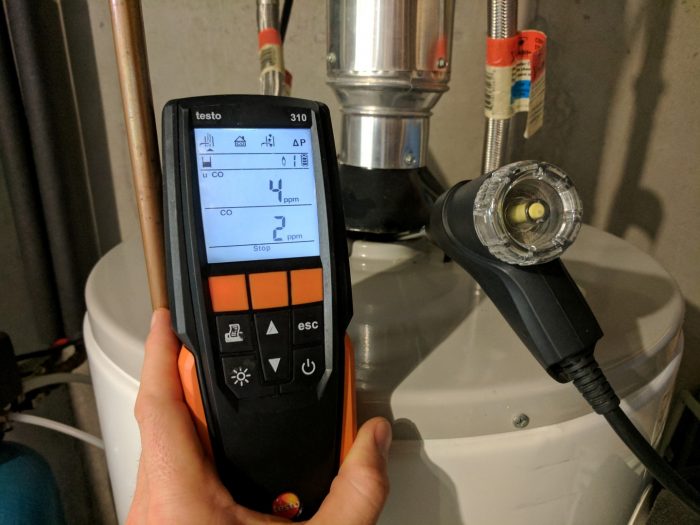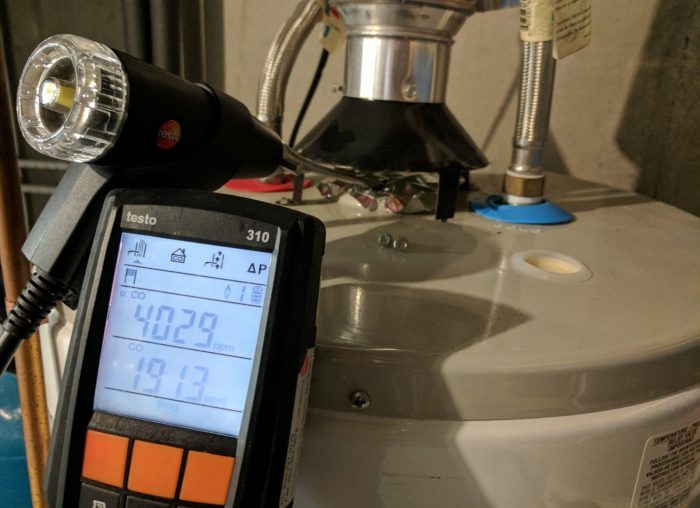I recently did a video blog post showing the process involved in replacing a water heater, wherein I helped my dad replace his old 50-gallon natural draft unit with a new one. I had a few people ask me why in the world my dad chose to go with the exact same natural draft water heater when he could have installed a powervent, direct vent, or tankless water heater. That’s a great question, and I think the answer deserves a blog post of its own. I’m going to do a three-part series, discussing three types of gas water heaters:
- Natural draft: a traditional water heater with a draft hood. Relies on gravity to get the exhaust gas out of the home.
- Powervent: has a fan on top that pushes the exhaust gas out of the home, typically through a PVC pipe out the side of the house.
- Tankless: there’s no tank. The water gets instantly heated as it passes through the water heater. All but the very oldest models of tankless water heaters will be “powervented” out the side of the house, but the term powervent is reserved for water heaters that have a tank.
Another term that you might hear is “direct vent”. This refers to a water heater that is constructed and installed to obtain all of its combustion air directly from the outdoors, and discharges all of its flue gas directly to the outdoors. This is not a definitive term for a water heater because it could describe many different types.
Are natural draft water heaters bad?
I don’t think they’re bad, but most people in the building science community seem to dislike atmospherically vented appliances. Just check out Allison Bailes’ post on the topic: 3 Problems with Atmospheric Combustion Inside the Building Envelope. Not only do atmospherically vented appliances use conditioned household air for combustion, but they also have an increased potential to backdraft. In the case of traditional water heaters, they simply rely on gravity to get the exhaust gas out of the home. Exhaust gas is lighter than the surrounding air, so it rises. Put a vent on top of the water heater, and we trust the exhaust gas to rise up the vent and leave the home without bothering us.
So what happens when you have a tight house and a bunch of other indoor fans running, such as a bath fan, a clothes dryer, and a kitchen hood fan? Every cubic foot of air that leaves the house needs to be replaced. When the fans are pulling a bunch of air out, a bunch of air needs to come back in. If the house isn’t leaky enough or there isn’t sufficient combustion air brought into the home, a building will be happy to suck air in through the water heater vent. After all, the vent is simply a hole to the outdoors. We trust that gravity will keep the air going out, but fans will win that battle every time. On an especially windy day, the wind can also overpower a gravity vent. When this happens, we call it backdrafting.
How dangerous is a backdrafting water heater, really?
Backdrafting is dangerous because exhaust gas contains carbon monoxide. While a properly operating water heater will produce extremely low levels of carbon monoxide, that’s not always the case with a backdrafting water heater. When a water heater backdrafts, the combustion process changes, and the water heater may start generating high levels of carbon monoxide. For a simple demonstration, I did a test on my own water heater, venting under normal conditions. It produced about 2 parts per million of carbon monoxide, or 4 parts per million if you don’t factor in the oxygen. That higher number is considered the “undiluted”, “air-free” or “oxygen-free” reading.
For the second part of my test, I blocked the vent at my water heater with some foil tape and fired it up. The CO level instantly skyrocketed. I took a photo of my meter with the CO level in the thousands, but the level quickly got into the tens of thousands before I shut my water heater off. To give that number some perspective, water heaters are supposed to be red-tagged and shut down when the oxygen-free level is over 400 parts per million. Once you’re into the thousands, it’s downright scary. That’s why I didn’t take the time to take another photo.
Side note: do you see the melted plastic at my water heater’s draft hood in the photo above? This happened because the flue cap at the top of my vent fell apart, causing my water heater to backdraft on a couple of extremely windy days. I posted about this on the Structure Tech Facebook page last year: Reuben’s damaged vent cap.
So how likely is it for a water heater to backdraft and produce high levels of CO? Not very. The draft hood is there so that if the water heater does start backdrafting for one reason or another, it will probably just spill low levels of carbon monoxide into the room. Nevertheless, backdrafting is unacceptable and unsafe, and should be corrected immediately. According to CPSC statistics, there is an average of five deaths per year associated with carbon monoxide poisoning from water heaters, so this is a ‘thing’.
How to increase safety
The best way to minimize any safety issues associated with backdrafting at a water heater is to not have a water heater that could backdraft. That means no reliance on gravity to get the exhaust gas out of the building. The most popular way of doing this is to install a powervent unit, which uses a fan to force the exhaust gas out through its own dedicated vent. I’ll discuss other options in another blog post, but for now, let’s take a look at the positive aspects of a natural draft water heater.
Benefits
- No electricity: Natural draft water heaters don’t use any electricity. If the power goes out, you still get hot water.
- Quiet: Natural draft water heaters are nearly silent. You can usually hear a little “whoosh” when they first ignite, but that’s all.
- Inexpensive: Natural draft water heaters are nearly half the price of powervent water heaters, which have become the standard replacement for natural draft water heaters. Besides the additional cost of the water heater itself, switching over from a natural draft water heater to a powervent means that new venting needs to be installed. New venting equates to a far more involved project, which of course equates to a far higher price tag; typically around 75% – 100% more money. Again, I’ll discuss powervent water heaters in next week’s blog post.
- Reliable: Natural draft water heaters don’t have any moving parts, other than the gas valve. Less moving parts means less opportunity for stuff to go wrong.
When making a safety decision, you weigh the risks against the added costs. For me, the added risk of installing a natural draft water heater isn’t enough to justify the alternative, which is the additional cost of a powervent water heater. For anyone who isn’t willing to accept that risk, you’ll need to use something other than a natural draft water heater.



Tim
February 7, 2017, 12:08 pm
Wow! You’re scaring me standing next to an appliance putting out nearly 200 ppm of CO! Love your blog, stay healthy!!
Reuben Saltzman
February 7, 2017, 4:28 pm
It scared me too 🙂
Chuck Macomber
February 7, 2017, 2:55 pm
I’ll throw one more type of water heater at you: Indirect Water Heater. We’ve got a water heater that uses an embedded internal coil that is fed from the boiler. So one natural gas appliance – the boiler – heats the radiators and also heats the hot water.
Reuben Saltzman
February 7, 2017, 4:29 pm
Yes, those are pretty
coolhot units.Water heater replacement: pros and cons of powervent water heaters - Structure Tech Home Inspections Structure Tech Home Inspections
February 21, 2017, 6:00 am
[…] homes here in Minnesota, but are they really that great? As I mentioned in my last blog post about natural draft water heaters, a powervent water heater is equipped with a built-in fan that pushes the exhaust gas out of the […]
Steve Fester
April 18, 2017, 8:54 pm
Reuben, thanks for this post. Milind inspected the 1955 story-and-a-half house I ended up purchasing in Roseville last spring, and I’ve referenced the inspection report often as a first-time homeowner. I’ve been considering a powervented water heater so I can get rid of the deteriorating masonry chimney that is only currently venting my natural draft water heater. The roof is going to be replaced this year, so I would like to have the chimney removed to the attic floor at the same time. Is there a way to keep using the part of the chimney below the attic floor (which I believe is in good condition) to vent the water heater? I’ve done some reading online about using a “B-vent” but not sure if it would be up to code. Any thoughts? I’d like to stick with natural draft if possible. Thanks.
Reuben Saltzman
April 25, 2017, 2:44 pm
Hi Steve,
Yes, you could do what you’re describing, provided you replace the entire vent liner with a B-vent.
Water heater replacement: pros and cons of powervent water heaters – My Blog
May 1, 2017, 7:14 am
[…] here in Minnesota, but are they really that great? As I mentioned in my last blog post about natural draft water heaters, a powervent water heater is equipped with a built-in fan that pushes the exhaust gas out of the […]
Water heater replacement: pros and cons of powervent water heaters – HomesMSP
May 1, 2017, 10:36 am
[…] here in Minnesota, but are they really that great? As I mentioned in my last blog post about natural draft water heaters, a powervent water heater is equipped with a built-in fan that pushes the exhaust gas out of the […]